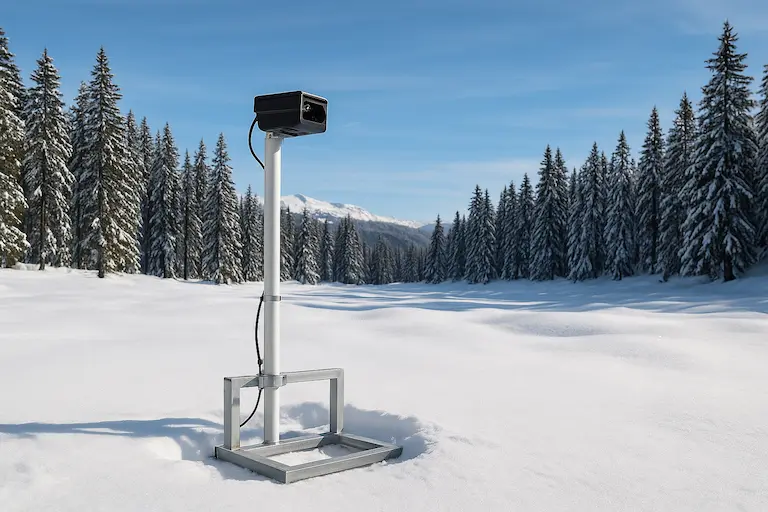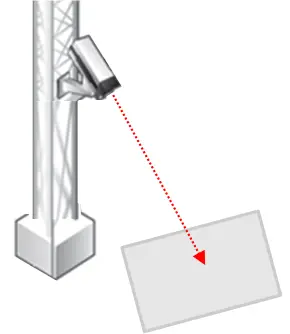Case Study: Outdoor Snow Monitoring System Using Multi-Point Laser Modules

1. Background: Why Snow Depth Measurement Matters
Snow depth monitoring is a critical parameter for meteorological observation, road safety management, hydrological modeling, and ski resort operations.
Accurate real-time snow depth data helps:
- Predict avalanche risk and water resource supply.
- Manage road clearing operations and reduce traffic hazards.
- Optimize snowmaking and slope management in ski resorts.
Traditionally, snow depth has been measured using ultrasonic sensors or manual methods. However, these approaches are prone to errors under windy, icy, or low-temperature conditions. As a result, laser-based snow depth measurement sensors are increasingly preferred for their high precision, non-contact operation, and long-term reliability in harsh environments.
2. How Laser Distance Sensors Measure Snow Depth
Laser distance sensors operate on the Time-of-Flight (ToF) principle — emitting a short laser pulse and measuring the time it takes for the reflection to return from the snow surface.
By continuously monitoring the distance between the sensor and the ground, snow accumulation can be calculated as:
Snow Depth = Reference Ground Distance – Measured Snow Surface Distance
Compared to ultrasonic sensors, laser sensors offer:
- Higher accuracy (millimeter-level vs. centimeter-level).
- Better stability in windy and low-humidity environments.
- Stronger resistance to temperature fluctuations and acoustic noise.
3. Challenges in Snow Surface Measurement
While laser distance sensors provide precise data, outdoor snow measurement presents unique challenges:
- Variable reflectivity: Fresh powder snow and compacted snow differ greatly in optical reflectivity, which can affect laser signal strength.
- Surface irregularity: Snow accumulation is uneven, especially under windy conditions.
- Temperature and frost effects: Extremely low temperatures may cause lens frosting or signal drift.
Without proper configuration, these factors may lead to inconsistent readings over time.
4. Solution: Optimized Laser Sensing System for Snow Depth Measurement
To overcome these challenges, a multi-module laser measurement approach has been developed.
(1) Multi-Point Averaging Method
Using three laser distance sensors positioned at different angles and locations, the system calculates the average snow height across multiple points.
This minimizes errors caused by uneven snow distribution and provides a more representative snow depth reading.
(2) Temperature Compensation & Anti-Frost Mechanism
Each sensor integrates a temperature compensation algorithm to ensure consistent performance from -40°C to +60°C.
Additionally, anti-frost coatings and optional lens heaters prevent ice buildup that could block the optical path.
(3) Installation Angle & Mounting Optimization
Sensors are installed with a 5–10° downward tilt, avoiding direct vertical reflection and reducing noise from low-angle scattering.
A stable aluminum mounting frame minimizes vibration and drift during long-term outdoor deployment.
5. Recommended Products & Configuration
For snow depth monitoring systems, the following configurations are commonly adopted:
| Parameter | Recommended Specification |
|---|---|
| Measurement Range | 0.05 – 50 m |
| Accuracy | ±1 mm |
| Operating Temperature | -40°C to +60°C |
| Output Interface | RS485 / UART / Analog 4–20 mA |
| Protection Level | IP67 (optional IP68) |
| Power Supply | 9–30 V DC |
Suggested Product:
Meskernel TS1224 Industrial Laser Distance Sensor
- High accuracy and compact design
- Stable performance under snow, fog, and sunlight
- Supports multi-sensor synchronization for averaging measurement
6. Results and Benefits
Field tests conducted in outdoor weather stations demonstrated:
- Accuracy deviation < 3 mm under variable snow conditions.
- Reliable performance across seasonal temperature changes.
- Maintenance-free operation for over six months of continuous monitoring.
These results validate that laser-based snow depth measurement systems provide high-precision, stable, and scalable solutions for environmental monitoring networks.
7. Conclusion
By integrating laser distance sensors with multi-point averaging and temperature-compensated calibration, modern snow depth measurement systems achieve unprecedented precision and reliability.
This technology is reshaping meteorological monitoring, improving data accuracy for weather models, and ensuring safer, smarter winter infrastructure management.
Frequently Asked Questions (FAQ) About Snow Depth Measurement
-
What is the most accurate method for snow depth measurement?
The most accurate method for snow depth measurement is using laser distance sensors based on the Time-of-Flight (ToF) principle.
Unlike ultrasonic or manual measurement, laser systems deliver millimeter-level accuracy and are less affected by wind, humidity, and ambient noise.
By continuously comparing the measured distance from the sensor to the ground, the system calculates the snow accumulation precisely in real time.
Laser-based snow depth measurement provides stable, repeatable data—essential for meteorological stations, ski resorts, and hydrological monitoring systems. -
How does sunlight affect laser snow depth measurement accuracy?
Direct sunlight can interfere with the laser signal and reduce the accuracy of snow depth measurements, especially when snow surfaces are highly reflective.
Meskernel sensors use:
Narrow-band optical filters to block unwanted light wavelengths.
Automatic gain control (AGC) to adjust signal strength dynamically.
Optimized installation angles (5–10° tilt) to avoid direct reflection.
These improvements allow consistent snow depth measurement accuracy even under 100k lux sunlight conditions. -
How can temperature variations impact snow depth monitoring?
Temperature changes can lead to signal drift in long-term snow depth monitoring systems.
To prevent this:
Each laser module features real-time temperature compensation algorithms.
Optional internal heaters prevent frost and maintain optical clarity.
Calibration can be adjusted for specific thermal conditions to eliminate offset.
Our tests show that Meskernel sensors maintain ±1 mm stability between –40°C and +60°C, ensuring reliable snow depth measurement all year round. -
What’s the best way to handle uneven snow surfaces or angular misalignment?
Uneven snow surfaces cause local measurement bias, especially in windy or sloped areas.
The solution is multi-point averaging — using three synchronized laser distance sensors mounted at slightly different angles.
This approach provides a representative average snow depth value, minimizing error caused by small angular misalignment.
The multi-point method is a proven technique to stabilize long-term snow depth measurements in outdoor conditions. -
Can laser-based snow depth sensors operate reliably during snowfall or fog?
Yes. Snowfall and fog introduce backscatter that can affect traditional sensors, but Meskernel’s laser snow measurement sensors feature:
Adaptive integration time to maintain signal strength.
Real-time filtering algorithms to remove false reflections from snowflakes.
Anti-fog lens coatings and air-purge options to keep optics clear.
This ensures uninterrupted snow depth monitoring even in low-visibility winter conditions. -
What’s the recommended installation setup for accurate snow depth measurement?
For best results:
Mount the sensor 1.5–2.5 m above ground, tilted 5–10° downward.
Avoid direct sunlight paths and nearby reflective objects.
Use a rigid aluminum bracket to minimize vibration.
Implement multi-point averaging if terrain is irregular.
Correct installation directly impacts the accuracy of your snow depth measurement system. -
How do I integrate the sensor into a remote snow depth monitoring network?
Meskernel laser sensors support multiple industrial interfaces:
RS485 / Modbus RTU for long-distance communication.
UART / TTL for embedded controllers.
4–20 mA analog output for PLC-based systems.
Data can be transmitted to cloud platforms for remote snow depth monitoring and real-time analysis. -
What is the expected accuracy and measurement range?
Typical field accuracy:
±1 mm under stable, low-wind conditions.
±3 mm under direct sunlight or heavy snowfall.
Measurement range: 0.05 m to 50 m, depending on sensor model.
Combining this accuracy with averaging algorithms yields highly reliable snow depth measurements for scientific and industrial use. -
Can Meskernel provide technical support for field calibration and testing?
Absolutely. When purchasing Meskernel snow depth measurement sensors, customers gain access to:
Expert guidance on optical filter and heater setup.
Custom calibration data for specific climates.
Remote firmware tuning and parameter optimization.
Continuous support for field deployment and long-term stability testing.
Our engineering team assists throughout your snow depth measurement project, from prototype testing to mass deployment. -
Are these snow depth sensors suitable for long-term outdoor use?
Yes. All Meskernel modules feature IP67/IP68-rated waterproof housing, anti-UV glass, and hydrophobic coatings to prevent snow accumulation.
Long-term field deployments in alpine regions have shown stable performance for 6+ months without maintenance, proving the system’s durability for year-round snow depth measurement.




